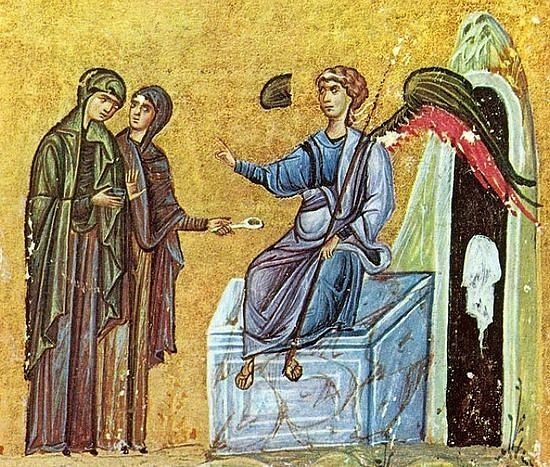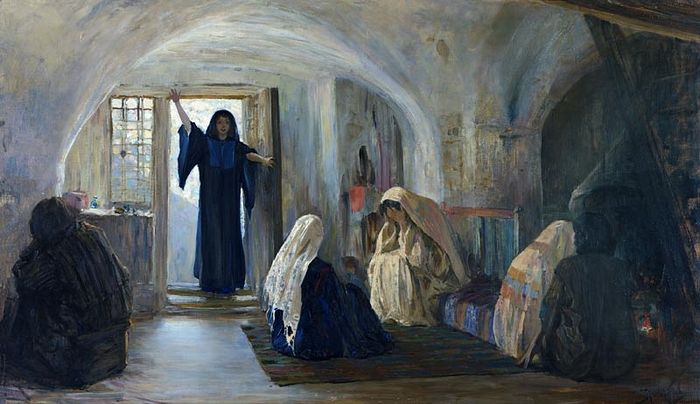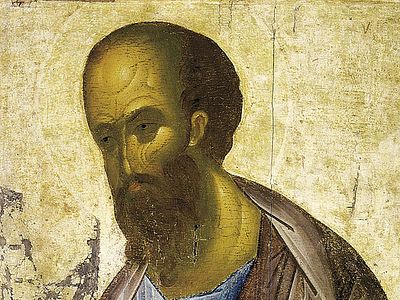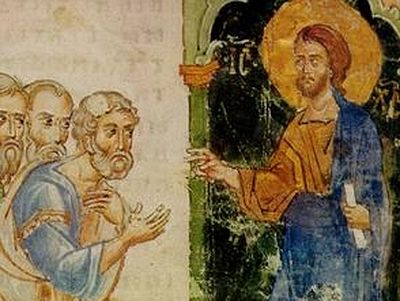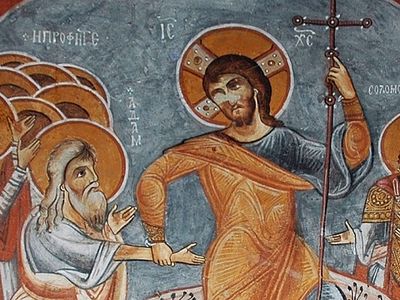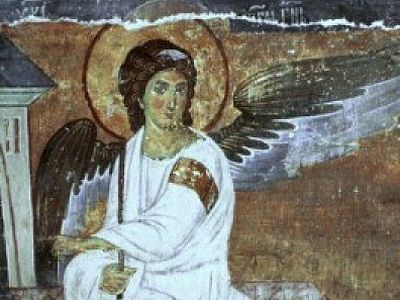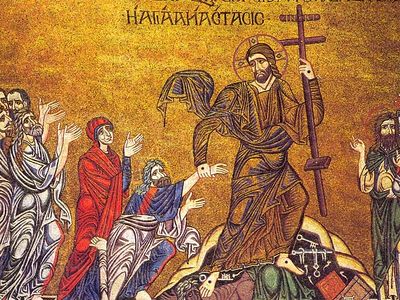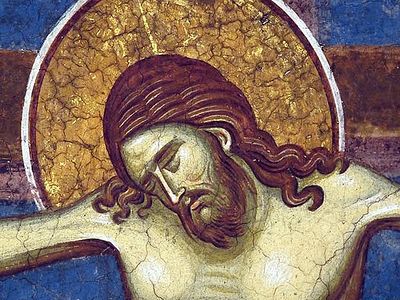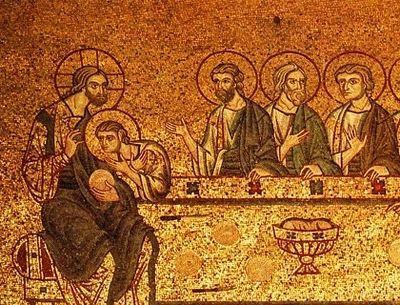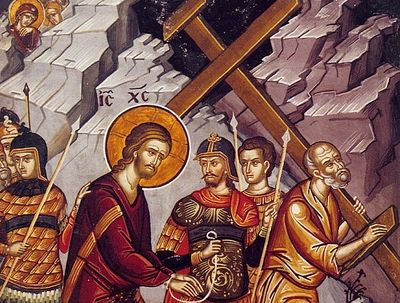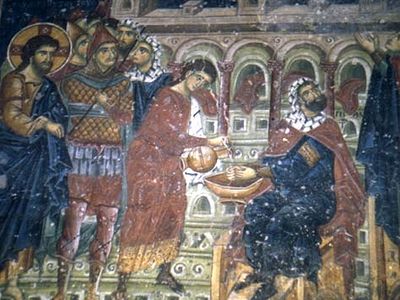See Christ is Risen, Part 2. The Empty Tomb
Now let’s continue with the second part of lesson two on the Resurrection. When the women find the empty tomb they are alarmed, and this is because grave robbery was a very big problem in antiquity. When Mary discovers the empty tomb, her fear is that the grave has been robbed, because this was enough of a problem in antiquity that the emperor Claudius, who reigned shortly after this, from 41 to 54, issued an edict ordering capital punishment for everyone who destroyed tombs, removed bodies, disrupted gravestones etc.. And a copy of this edict was actually found in Nazareth. So this was a big problem. The empty tomb by itself would not have necessarily indicated to the women that the Lord had risen. So that’s why we need the angelic appearances: The angels explain the empty tomb to the women because they would not have assumed that He had risen based on the empty tomb itself.
The Myrrhbearers
The angels appear in the case of the appearance to the myrrhbearers. They say, “He’s not here. He is risen, as He said.” They remind them that the Lord made predictions of His Resurrection, which suggests that the women also knew about these predictions. Remember that they were part of the group of disciples. They were part of the retinue or the entourage of Christ. They also followed Him, and not just The Twelve. We’ll talk about this too at some point. Jesus didn’t just travel the countryside with twelve guys. There were women who traveled with them. They had heard Him. They would hear Him preaching. They heard many of these predictions. They weren’t present for everything, of course, and sometimes the Lord took The Twelve aside for special instruction. Sometimes He took just three aside: Peter, James and John, etc.; but the women also heard plenty of things from the Lord. This is why they were apostles: they heard lots of teachings.
They heard the Lord teach and preach many, many times, and when they went out as apostles and told about the Lord’s preaching. I’m talking about the women now. Remember—there were women apostles because they were eyewitnesses to the Resurrection. They knew His teaching. They had seen His miracles too, just like the men. So the women are also told by the angels to see where He lay. They’re given the invitation. They’re invited to see the place where they had seen Him being put before. They are the ones who witnessed His burial, and there’s no chance of a mistake: “Look, here’s the tomb. You saw Him before. Remember when you saw Him lying there? His body had been placed there and you saw the stone being rolled over the tomb?” And in the Gospel of Matthew, the tomb is opened in their presence, and the guards are still there. It says the guards were shaken, they were horrified, and the tomb is empty. It’s opened in their presence and it’s empty. There’s no other explanation but His Resurrection.
St. Cyril of Alexandria, one of the Fathers from the fifth century—he’s the one who defended Orthodox doctrine against Nestorianism—wrote a commentary on John, and I want to tell you what he has to say about the angelic appearance to Mary Magdalene: “One may raise the question, not unreasonably, how it was that the blessed angels said nothing to the holy disciples, and did not even appear to them, but were both seen by the woman and also spoke to her.” Here, because it’s the Gospel of John, he’s talking about just Mary Magdalene. But you can make the same argument about how the angels appear only to the women. The men do not see the angels, do they? “We reply then that it was the object of the Savior Christ, to instill into the minds of those who loved Him, the perfect knowledge of the mystery concerning Him, but that this perfect knowledge was in different ways given unto them and adapted to the requirements of those who stood in need of it.”
He says that different things happen to different people depending upon their needs. Thus, the women see the angels, but the men don’t see the angels. Jesus sometimes appears recognizable to the disciples, and sometimes He’s not recognizable. So whatever it was that the various disciples needed (and I’m including, women and men, the Eleven and others who were not of the Eleven, like Cleopas and the other on the road to Emmaus) is what He did, what the Lord provided.
So, Cleopas and the other disciple were discussing what had happened, and the Lord comes up alongside them. And what does He do? He explains the Scriptures to them, because that’s what they needed to understand. Sometimes He allows them to touch Him, and sometimes He doesn’t. If they need to touch Him, like Thomas and the eleven, then they touch Him, but He doesn’t allow Mary Magdalene to touch Him for another reason: she needs to understand something else, which I’m going to get to in a minute. So, everything is tailored to what they need. It’s really a beautiful concept when you think about it—that He gives them what they need. It’s very individualized and I love that, because we really do that very much in the Church. We think of ourselves as having rules, but the truth is there’s a lot of flexibility in Orthodoxy. We don’t have “one size fits all.” There’s flexibility in how we do things, it’s tailored to what people need; and the Lord does this too.
Let’s continue talking about the Lord’s appearance to the women, to the myrrhbearers. When He sees the myrrhbearers, and this is in the Gospel of Matthew, He says “hairete”, “rejoice” or “hail.” This was the typical Greek greeting and it was comparable to our “hello,” but it means “rejoice.” The women, of course, being the first witnesses of the bodily Resurrection of Christ, hear this greeting, “Rejoice!” And they grab hold of Him, they fall at His feet, and of course we have in this evidence of the physical Resurrection. The Gospel of Matthew also tells us that they fall down at His feet when they see Him and they worship Him. And the word that is used is the same word we use in Church when we call to prayer: “thefte proskinisomen”—“Come let us worship and fall down before Christ.” That’s the word used in Matthew’s Gospel for the reaction of the women when they see the Risen Christ: they fall down at His feet and worship Him. Now the women go and tell the disciples about the empty tomb, and of course, Luke alone relates the fact that the men did not believe. He’s very sensitive to the situation of women. Luke is the one who tells us more about the women disciples than any other Evangelist. The others just don’t tell us whether or not they were believed. We also have a story of one or two disciples running to the tomb. Luke only tells us about Peter. John tells us about Peter running to the tomb and the Beloved Disciple running to the tomb. I think that there were probably other disciples who also went to the tomb. But their stories are not told—because if you were one of the disciples, wouldn’t you go to the tomb and check it out for yourself? So the fact is, they don’t tell us about everything that happened. Other things happened that we don’t know about.
The grave clothes
Now, it tells us also that when the disciples go to see for themselves the empty tomb, they see the grave cloths left behind. This is important, because someone stealing the body would not have left these cloths behind, and it wouldn’t have been easy to remove them anyhow. Further, the Gospel of John tells us that when the Beloved disciple sees the cloths, “He saw and he believed.” At least the Beloved Disciple believes, just on the basis of the seeing the cloth lying there.
Mary Magdalene
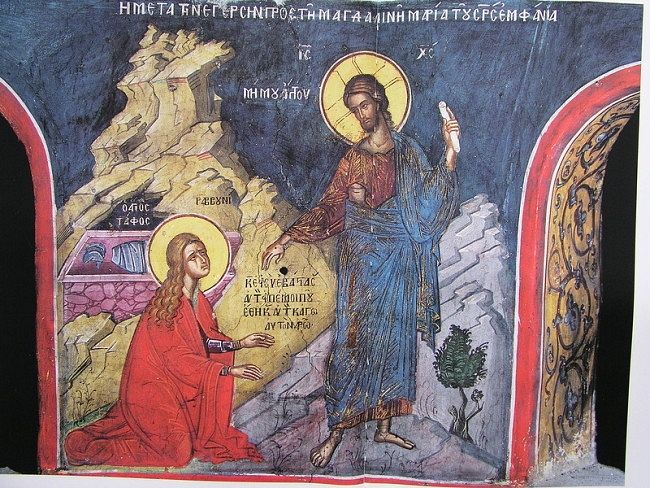 Appearance of Christ To Mary Magdalene. A painting of the katholikon of Dionysiou Monastery on Mt. Athos. Middle of XVI C.
Appearance of Christ To Mary Magdalene. A painting of the katholikon of Dionysiou Monastery on Mt. Athos. Middle of XVI C. After this we also have, in the Gospel of John, the appearance of the Lord to Mary Magdalene. And the Beloved Disciple—that is, John—and Peter, after seeing the empty tomb for themselves, return home. But Mary still does not get it. She’s around the empty tomb, she’s very distressed. Perhaps there had been other women with her who find the empty tomb, and she stays there just crying. So again I’m not trying to harmonize, but you can see how these things could all have happened. They don’t necessarily disagree with each other, because it doesn’t tell us who came and who went back and forth, etc. She is distressed at the thought that the Lord’s body had been stolen. This was a great outrage, a terrible thing. If this had happened to anyone we love we would be similarly extremely upset. Chrysostom tells us that she stayed behind weeping because Peter and John understood the meaning of the empty tomb and the grave clothes, but she did not. He also tells us that Mary was gradually brought to an understanding of the Resurrection—first by the empty tomb, then by the angels, then by the appearance of the Lord Whom she did not recognize, and then she recognizes Him. And when He tells her not to touch Him she gets a better understanding of what this all means. Thus is she brought gradually, by degrees, to an understanding of the resurrection and what it means.
So, she’s left there weeping by the tomb. She doesn’t understand. She stops and turns her back, and goes to stoop down and look at the tomb again—the way you look for something that is lost and you know it’s not there, but you go back to the place where it should be and look, even though you know it’s not there. She knows the grave is empty, but she stoops down and looks inside again to see where His body should have been. And instead of the body being there now, she sees two angels sitting inside the tomb, who appear just to her and ask, “Woman, why are you weeping?” She explains “Because they’ve taken away my Lord and I don’t know where they have laid Him.” And then she turns around. She turns away from the sight of the angels. Chrysostom explains this (and if you think about it, if you had two angels sitting in front of you, would you look away and turn your back on them?) thus: She turns away from the sight of the angels because the angels saw the Lord standing behind her, and they react to His presence. So she turns around because she realizes that there is someone standing behind her. This is how he explains it. She is aware of the presence of another person, and she does not immediately recognize Him as the Lord, just as sometimes the disciples do not recognize Him. Sometimes they recognize Him right away and other times they don’t. The disciples on the road to Emmaus do not recognize Him immediately. The disciples who go fishing do not recognize Him immediately, and so on.
Removing the ancient sorrow.
St. Cyril of Alexandria tells us that she does not recognize Christ because it is still somewhat dark outside. Chrysostom tells us that she does not recognize Christ because He makes Himself known only when He wishes it. He allows her to recognize Him when it’s appropriate for her to recognize Him. So you see here, that two different Fathers give us different interpretations of what this means. Thus, the Fathers do not always agree on everything, and you should be aware of that. But St. Cyril has some beautiful things to say about the interaction here between Mary and the Lord, and I want to share it with you. He reminds us that the Lord asks, “Woman, why are you weeping? Who are you looking for?” Here’s what Cyril has to say: “That is to say, ‘Wipe away your tears, I am alive, I am here, give up your lamentations. On the contrary, be of good cheer.’ He asked the question then wishing to end her sorrow. For it was meet that the Lord should be our restorer in this way also.” Isn’t that nice? He says the Lord restores us also by ending our sorrow. Now listen to what St. Cyril is saying here: “For by Adam’s transgression, as in the first fruits of the race, the sentence went forth to the whole world: Dust thou art, and to dust thou shall return; and to the women in special: In sorrow thou shalt bring forth children. To be rich in sorrow, then, as by way of a penalty, was the fate of woman. It was, therefore, necessary that by the mouth of Him that had passed the sentence of condemnation, the burden of that ancient curse should be removed, our Savior Christ now wiping away the tears from the eyes of the woman, or rather of all womankind, as in Mary the first fruits. For she, the first of women being offended at the death of the Savior, and grieving thereat, was thought worthy to hear the voice that cut short her weeping, the power of the word in fact extending also to the whole race of women.”
Well, first of all, I want you to notice in that comment by Cyril of Alexandria the fact that he says it was the Christ, it was the Lord who “passed the sentence of condemnation”—that’s what he means, against Adam and Eve, what was to be the result of the Fall. “By the sweat of your brow you shall earn your bread,” and that women would have sorrow or pain in childbirth. It is Christ who says that. I’m mentioning that to you because we’re going to be talking about this in our Introduction to the Bible. It is Christ in the Old Testament who does these things, and now He “undoes” them. And what Mary experiences—the joy; she is the first fruits of women to experience the joy of Christ, women having also been the ones who experienced great sorrow. And I think it’s a beautiful sensitivity that Cyril shows here to the fact, the truth, that women tend to be much more sorrowful. They feel things very deeply. They’re the ones who are grieving. She’s the one who’s mourning more than anyone else. The others, Peter and John, went back home but she’s still there by the tomb mourning and grieving, because she loves Him so much. He removes her sorrow. He finds her worthy to hear the word that removes the sorrow not from only from her, but from the whole of womankind.
So let us continue with another comment of Cyril of Alexandria on this: “He bids her refrain from weeping, releasing her from that curse which bound her unto sorrow. He bids her to be the first messenger of tidings of great joy and proclaim to the disciples His journey heavenward, that as the first woman, the mother of all mankind was condemned for listening to the devil’s voice and through her the whole race of women, so also this woman, in that she had hearkened to our Savior’s words and announced tidings fraught with eternal life, might deliver the entire race of women from the charge of old.” So, the fact is, when the Lord says her name, Mary recognizes Him, and she responds joyfully. There’s a lot we can say about the fact that she recognized Him when He calls out her name, but we’ll have to leave that for when we talk about the Gospel of John. She responds very joyfully. She’s ecstatic that He’s alive again and she thinks life is going to return to the way it was before, that their relationship will continue. She calls Him “Rabbi,” and He tells her, “Don’t touch me.” It’s a strange comment; and it doesn’t say whether or not she touched Him. I think you could go either way on that, but He says, “Don’t touch me.” She may have immediately grabbed Him, immediately hugged him, but she considers Him the Rabbi. Look at how she responds. The way she responds is different from the way Thomas responds when He sees the Lord. She says “Rabbouni!” “Teacher!” and the Lord says, “Don’t touch me.” And there is a correlation that she falls at His feet, adores Him, clasps Him, very similar to the way the other myrrhbearers respond to seeing Him.
“Don’t touch Me.”
Why does He say, “Don’t touch me”? Here’s what Chrysostom has to say about this. He tells her this because, basically, she still has no appreciation for what has happened. “She does not realize His greatness.” This is what Chrysostom says. He wants her to abandon this notion that things will be the same as they were before and He wants her to refrain from treating Him with too much familiarity. He elevates her thoughts, that she will treat Him with a more reverential attitude. So He says he is going to Heaven now, as though He had said, “Do not touch me as you did before, because things are not the same now as they were before. I will not associate with you in the future the way I did before. I was your rabbi. You were my disciple, and it’s not going to be the same anymore.” Cyril of Alexandria has basically the same understanding of what the Lord means by the words, “Don’t touch me”—here we see consistency between these two Fathers in the way they interpret this statement.
Here’s what Cyril of Alexandria has to say: "Therefore, before the saving Cross and the Resurrection from the dead, while as yet His providential scheme had not received its appropriate fulfillment, He mingled both with the just and the unjust and ate with publicans and sinners, allowing any that so willed to come to Him and to touch His holy body, that He might sanctify all men and call them to the knowledge of the truth.” Cyril actually continues in this particular passage in His commentary on John, and continues to relate this to Communion, that although before the Resurrection the Lord mingled with everyone, the just and the sinners, and allowed anyone to touch Him who wanted to touch Him, after the Resurrection this doesn’t happen. He uses this to talk about how Communion is reserved only for the baptized and not given to just anyone—a rather interesting correlation—but basically what He’s saying is that anyone could touch Him before but now things are different.
Now what about the appearance to The Eleven disciples? Mary and the other myrrhbearers are told to give the message of the Resurrection to the disciples. Only Luke tells us that the women are not believed. In Matthew they’re told to go and tell the disciples, but we don’t know whether or not they believe them—at least Matthew doesn’t tell us what happened. So the disciples don’t believe them, and it is necessary for the Lord Himself to come and appear to them. He does so in the upper room. Luke simply tells us that He appears to the disciples, but He doesn’t tell us whether Thomas was present or not. John tells us that the first time Thomas is not present, but later He is. What the Fathers do tell us is that the Lord appears to the disciples as condescension to their weakness, and the weakness of humans in general—to our inability to comprehend, our inability to understand, to accept the meaning of the empty tomb, the meaning of the burial, etc.
“Peace be with you.”
Chrysostom has something very nice to say about when the Lord appears to the disciples, He says to them, “Peace be with you.” He notes that when the Lord appears to the women, He says “Rejoice!” but when He appears to the male disciples He says “Peace be with you.” He says “Rejoice!” to the women because they were in great sorrow, and His words brought them joy; but to the male disciples He says “Peace be with you,” because they were very agitated, and His words calmed them. Thus, I think this is a very excellent point and again shows us that the Lord does whatever is needed for each particular disciple or group of disciples. He shows Himself to them in the manner they need, either as in the case of Mary Magdalene, gradually bringing her to an understanding of the Resurrection, appearing in a way that they will recognize Him when they need to recognize Him, or hiding His identity when necessary, and so on.
He shows Himself to them in the upper room. The doors are shut or locked, and He instantly materializes among them, showing us His power and ability to appear or disappear immediately. This is something that is quite inconsistent with the limitations of our physical bodies. He is physical. He allows them to touch Him, yet there’s something different about Him, and we can’t really explain these matters any further, except that obviously the properties of the resurrected body are quite different. He’s not bound by space and time the way we are. He greets them with a typical greeting, “Irini imene,” (Peace be with you) or “Shalom” in Hebrew. And, as the prophets of the Old Testament understood this greeting “shalom,” it was the epitome of the blessings of the Kingdom of God, which have now been realized. We have the peace of God since the Resurrection, and there’s a great deal of meaning behind the fact that He greets them with “peace”, and not simply because they are agitated or upset. And at the farewell discourse in the Gospel of John He promised the disciples peace: “My peace I give to you, the peace that the world cannot give.” So the peace of Christ is not world peace. It’s much deeper than that: it’s a spiritual peace, the peace of the presence of Christ in our lives. This is the peace that He gives them.
Luke tells them that He appears in the upper room to the Eleven disciples. John tells us that the first time Thomas was not present, and then he tells us about this special appearance with Thomas present. Now did Thomas actually put his finger in the Lord’s hands or His side? The Gospel of John does not tell us. It only tells us his verbal reaction: “My Lord and my God!” There was a tradition that, in fact, he did touch the Lord. I think he probably would have touched the Lord. We know in the Gospel of Luke that the other disciples do touch the Lord. I would think he would want to touch Him. It would be natural for him to want to do so. Perhaps after this exclamation of faith he’s certainly overwhelmed by the appearance of the Lord and bursts out with his confession, certainly before he actually touches Him. Chrysostom says about Thomas’ insistence upon touching Christ, that Thomas was more crass than the other disciples; that is, he’s at a much lower level than the other disciples because he was seeking to have his faith substantiated or confirmed by the least spiritual of the senses. And the least spiritual sense is the sense of touch.
The obstinacy of Thomas
Listen to what Chrysostom has to say about this: “He did not even believe his eyes. He did not say, ‘Unless I see Him,’ but ‘Unless I feel Him with my hands.’ Just as it is an indication of gullibility to believe easily and carelessly, so to scrutinize and examine immoderately before believing is the mark of an obstinate will. That is why Thomas is blameworthy, for he refused to believe the apostles when they said, ‘We have seen the Lord,’ not so much because he did not trust them as because he considered the thing an impossibility—that is, the Resurrection from the dead. He did not say ‘I don’t believe you,’ but, ‘Unless I put my hand into His side, I will not believe.’ And when you see the disciple refusing to believe, reflect on the mercy shown by the Lord, how even for the sake of one soul He showed Himself with His wounds and came so that He might even save the one soul, despite the fact that this one was more crass than the others. Jesus once again stood in their midst, fulfilling the desires Thomas had expressed, thus proving that He was actually present when Thomas had uttered those words to the disciples. I say this for He used the selfsame words, though very reproachfully, and with the addition of an admonition for his future conduct.”
I think this might explain why Thomas immediately says, “My Lord and my God!”—not simply by seeing the Lord, but when Christ appears to Thomas He says, “Come over here and put your finger in the holes of the nails and put your hand in my side.” He’s echoing Thomas’ exact words, which Chrysostom says means that He was invisibly present when Thomas had said this, and so He brings Thomas’ words forward in His presence showing His divinity. And Thomas says, “My Lord and my God,” and his understanding is the full expression of faith that Christ is Lord and God.
Well, this lesson has gone on long enough, dear brothers and sisters, I think we need to stop at this point even though we didn’t get quite as far as I wanted. I hope you appreciated at least what I did cover. Next time we’ll talk about a little bit more about the nature of the resurrected body. We will talk about the so-called “family tomb of Christ,” that was supposedly discovered, and hyped in the media. I’m also going to address a question that a listener posed to me: “Why did Jesus have to die at all? Why didn’t God just simply forgive us our sins without the death of Christ on the cross? When this question was posed to me, at first I thought, “Well, it’s too bad I didn't think to address that question when we talked about the crucifixion.” But later I thought about it and said, “No, this really has to do with the Resurrection,” so I’m going to talk about that next time.
So let’s now close with our prayer: Christ is risen from the dead, trampling down death by death, and upon those in the tombs bestowing life!
Alithos Anesti o Kyrios. Truly the Lord is Risen.
Presbytera and Dr. Jeannie Constantinou’s podcasts can be found here.
